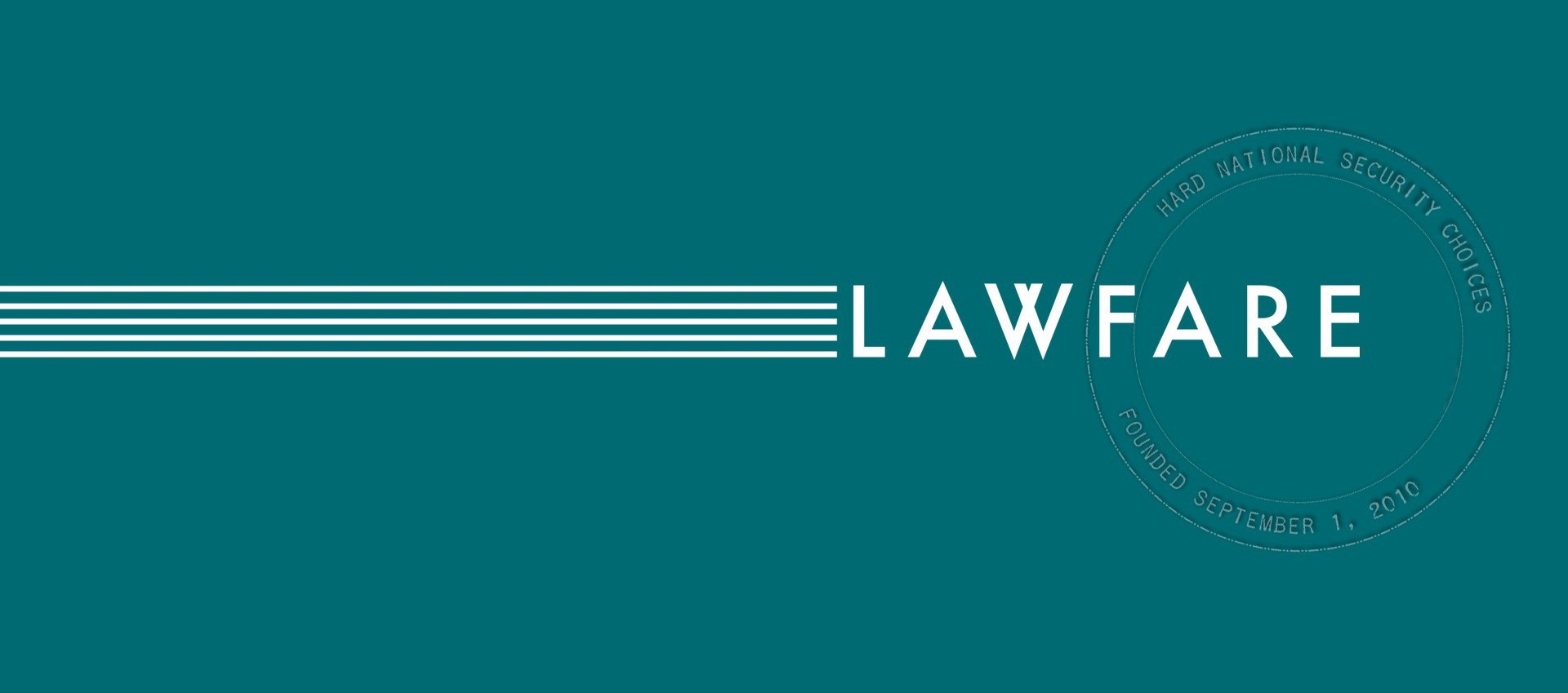Demystifying the Financial Action Task Force
A review of Julia Morse, “The Bankers’ Blacklist: Unofficial Market Enforcement and the Global Fight Against Illicit Financing” (Cornell University Press, 2021).

Published by The Lawfare Institute
in Cooperation With

A review of Julia Morse, “The Bankers’ Blacklist: Unofficial Market Enforcement and the Global Fight Against Illicit Financing” (Cornell University Press, 2021).
***
Unprecedented economic sanctions. SWIFT financial messaging bans. Central bank asset freezings. Russia’s invasion of Ukraine unleashed a new phase of economic warfare and heightened media and government attention to the opaque, byzantine world of international financial flows. Over the past six months, the G-7 and its partners implemented extensive multilateral economic sanctions, developed new uses of export control authorities, and rolled out the KleptoCapture and Russian Elites, Proxies, and Oligarchs (REPO) task forces. They also tried to close loopholes against Russian capital flight and sanctions evasion.
To implement many of these headline-catching initiatives, policymakers in Washington, Brussels, and beyond benefited from a global financial compliance architecture built up over the past three decades. Hundreds of thousands of dedicated financial crimes compliance professionals around the world shoulder the responsibility to police the global financial system for suspicious activity occurring in increasingly novel financial products and services. Some work for governments, but the overwhelming majority operate in the private sector within tens of thousands of regulated financial institutions. They contribute to broader anti-money laundering and countering the financing of terrorism (AML/CFT) public policy efforts that ramped up after the 9/11 attacks. Sitting at the top of this diffuse system is a 65-person, Paris-based intergovernmental standard-setting body called the Financial Action Task Force (FATF), which maintains an outsized yet understated role in shaping how trillions of dollars in value moves around the world every day. The FATF serves as the intergovernmental standard-setting body for AML/CFT compliance and periodically reviews countries on their implementation of these standards.
In a new book, “The Bankers’ Blacklist: Unofficial Market Enforcement and the Global Fight Against Illicit Financing,” political scientist Julia Morse of the University of California, Santa Barbara provides a comprehensive overview of the FATF’s evolution and unique characteristics. Morse rigorously examines how the FATF fits into, as well as fundamentally shapes, the international financial system through its technocratic review process of noncompliant jurisdictions. Her detailed research provides a thorough examination of the organization that moves beyond headlines to test out different theories of how this international organization works. Morse challenges the assumption that international standards like those from the FATF provide a “focal point” for market participants to internalize their compliance obligations. Rather, Morse reframes “the relationship between international standards, market pressure, and compliance” to demonstrate how domestic constituencies like banks shape government action to meet the FATF’s standards.
Origins of the FATF
The FATF exists as a unique institution in the international financial system and among international organizations. As a “soft law” mechanism, the FATF operates without binding legal treaty obligations; instead, its 39 member countries participate voluntarily. The FATF helps states develop regulatory and reputational controls because at their core “banks have few natural profit reasons to scrutinize financial transactions.” Yet governments have substantial interests in addressing criminal and national security threats posed in the aggregate by malign financial activity.
The G-7 created the FATF in 1989 with 16 members, initially to curb money laundering associated with the “war on drugs.” In 1990, the FATF published a report containing 40 recommendations for states to improve their money laundering-related legal and regulatory regimes. These recommendations became the foundation for the FATF as members expanded its remit to cover terrorism financing after the 9/11 attacks. The FATF’s mandate also continues to evolve as it now encompasses the “financing of proliferation of weapons of mass destruction, and to be clearer on transparency and tougher on corruption.” This stilted language from the FATF website typifies the technical nature of its work and the intensely negotiated public statements from the organization based on member and secretariat policy positions.
Given the voluntary nature and structure of the FATF, the organization and its members initially faced two problems: the inability to apply the recommendations to non-FATF members and the absence of a mechanism to enforce against noncompliance with the recommendations.
To expand its global reach, the FATF and its members creatively developed FATF-style regional bodies (FSRBs), a network now encompassing nine regions and over 200 economies. This network arrangement addressed the problem of applying the FATF standards to nonmembers by requiring FSRB participants to comply with the standards without fundamentally altering the governance or composition of the FATF.
The Grey List: How FATF Operates
The FATF’s most recognizable feature is the triannual publication of a graduated list of noncompliant jurisdictions, the so-called grey and black lists. North Korea and Iran retain a near-permanent place on the black list for “serious strategic deficiencies to counter money laundering, terrorist financing, and financing of proliferation.” However, the grey list of “jurisdictions under increased monitoring” fluctuates. The grey list currently identifies 23 countries, including NATO-member Turkey, as well as Pakistan and the United Arab Emirates. Countries on the grey list make high-level commitments to the FATF on AML/CFT reforms, with the goal of being removed over time. For critics who view the FATF as an American-controlled forum, Morse notes both technical and bureaucratic constraints that limit how the United States, like other members, intervene on narrow technical points and can develop coalitions among members to support certain initiatives. Morse found that, as a result of such limited ability to intervene, “at least eighteen official U.S. allies and several other economies with close ties to the United States” appeared on the grey list.
Morse does identify benefits of the FATF for the United States as well as other members. The FATF’s actions allow the United States in particular to “avoid[] some of the political enforcement costs of unilateral lists or direct coercion” such as through economic sanctions or the U.S. government’s USA Patriot Act Section 311 “primary money laundering concern” designation. Morse’s case study of a failed European Commission experiment with the FATF-like listing of noncompliant jurisdictions in 2019 further demonstrates the unique power, expertise, and legitimacy of the FATF.
Technical enforcement of the FATF’s standards presented an early challenge to the FATF as an organization. Here, Morse argues that the FATF evolved to rely on an unlikely nongovernmental source for enforcement of its standards: private-sector entities such as banks. While the FATF maintains its grey and black lists, it does not itself have a sanctioning tool to regulate commercial financial activity.
The Power of Unofficial Market Enforcement
Morse identifies “unofficial market enforcement” as the mechanism by which FATF “drives market decision-making through an information signal or focal point rather than direction coercion … [that] provide a shared expectation about how to behave.” Credible signals from the FATF, like placing a jurisdiction on its noncompliant grey list, mobilize domestic constituencies, like local banks and banking associations, to drive positive legislative and regulatory reforms in the absence of political will. The domestic political constituencies move away from a state-centric model to understand how the private sector influences state behavior. Morse provides case studies on the domestic political constituencies in countries like Thailand and the Philippines that mobilized to support the FATF’s standards through new legislation. Bankers most directly experience the heightened reputational and financial transaction costs when their jurisdiction is placed on the FATF grey list as other global financial institutions add more scrutiny and costs to transactions. In particular, these financial costs permeate more of the economy over time. Impacted businesses formally and informally mobilize their governments, including through the finance ministry and central bank bureaucracies, to change legislative requirements to comply with the FATF’s standards.
Additionally, Morse notes that “listed countries cannot directly lobby the FATF to stop market enforcement because the FATF is only indirectly responsible for the process. The FATF does not require banks to restrict capital to most countries on its noncomplier list; banks take this step on their own.” Here, Morse identifies a key source of the FATF’s power, as it ironically does not need to have a sanctioning capability because it implicitly delegates that function out to private financial institutions.
Sources of the FATF’s Strengths
Morse identifies four sources of the FATF’s power: technical expertise, access to information, coercive pressure, and institutional legitimacy. While small in number, the FATF’s secretariat is staffed by credible subject matter experts, often with extensive experience in member governments and financial institutions. The FATF develops strong working relationships with public- and private-sector stakeholders to develop unrivaled public assessments through mutual evaluation reports (MERs) of jurisdictional compliance with the FATF recommendations. Failure to comply with a certain number of MER criteria or other conditions triggers a negotiation process with the FATF staff. Lack of progress during such negotiations may, in turn, lead to public grey-listing. These three factors combine to provide FATF with a degree of institutional legitimacy distinct from, and sometimes more powerful than, its members.
Morse blends rigorous social science quantitative research with accessible qualitative interviews, along with relevant case studies on the Philippines and Thailand and field research to plenary meetings of the Asia/Pacific Group (APG) and European MONEYVAL, both FSRBs. Morse did not attend a FATF plenary meeting, which would have provided unique insights into FATF—indeed, critics of FATF lament its opaque processes, decision-making, and inaccessibility to the public—but she did observe meetings at two of nine FSRBs. Future research on FSRBs, particularly in places like Africa and Latin America, would be useful to understand how unofficial market enforcement displays in these regions.
Efficacy and Externalities
Unfortunately Morse does not address the efficacy of the FATF recommendations and its noncomplier list to restrict illicit financial flows by reducing money laundering and terrorism financing. To the author’s credit, Morse readily acknowledges the absence of an efficacy analysis in her research and frames it as “crucial” for further study. As a hopefully intermediate step to measuring efficacy, the FATF has implemented a new criteria to measure effectiveness in addition to technical compliance through the so-called 11 “immediate outcomes.” As states improve their compliance with the FATF standards through the formal banking sector, malign actors may increase reliance on alternative forms of capital movement outside of traditional banks, ranging from hedge funds to cryptocurrencies to money transfer mechanisms like hawala. Given the ingenuity and incentives of criminals and other malign actors, the FATF must continuously adapt to new and repurposed forms of illicit value transfer.
Morse recognizes the associated challenges presented by the FATF recommendations, particularly on developing countries as compliance ratchets up the cost of financial services or eliminates them altogether. This phenomenon is sometimes associated with de-risking, which, according to the State Department, involves “financial institutions terminating or restricting business relationships with clients or categories of clients to avoid, rather than manage, risk.” Morse fairly discusses the competing theories of de-risking, including changes to international correspondent banking that reduce or eliminate the profitability of certain cross-border banking relationships, increased regulatory requirements from the financial crisis, and AML/CFT obligations. Morse rightly calls on the FATF to better manage the impact of its framework on financial inclusion.
Afghanistan and Russia Test the FATF
Several recent developments over the past year continue to test the resiliency and durability of the FATF. While technically grounded and institutionally developed, the FATF cannot ignore the political and economic realities in which it operates. On an operational level, the unexpected resignation of the FATF’s president in late 2021 reignited questions about the organization’s independence from member interference. To its credit, the FATF has taken actions that show a commitment to institutional independence, for example placing both Turkey, a NATO ally, and the United Arab Emirates on its grey list despite both countries’ reform efforts to meet the FATF’s requirements.
However, on Afghanistan, the FATF released a mild statement after the Taliban recaptured the country last year despite the fact that United Nations, United States, European Union, and United Kingdom-designated terrorists now control the Afghan central bank (Da Afghanistan Bank, DAB) and the State Department found that the country’s financial intelligence unit, an essential institution for bilateral and multilateral cooperation under the FATF recommendations, “currently is non-operational.” On Russia, the FATF issued at least three statements condemning Russia’s actions in Ukraine. Most recently, it took a series of steps to exclude Russia from participating in the FATF’s leadership and advisory functions but stopped short of expelling the member country from the organization.
Emerging Frontier: Digital Assets
The FATF will continue to play an important standard-setting and monitoring role to address illicit financing risks in the global financial system. As reinforced in the March 9 Executive Order on “Ensuring Responsible Development of Digital Assets,” the Biden administration continues to push for enhanced implementation of these standards, particularly in weak jurisdictions. Digital assets like cryptocurrencies represent the latest iteration of new and emerging risks for the FATF to manage, much of which has evolved since Morse completed research.
Julia Morse provides groundbreaking research into the FATF that makes the FATF more accessible and serves as a very helpful guide for understanding how unofficial market enforcement can be harnessed to address AML/CFT risks at the country level, both now and into the future.




